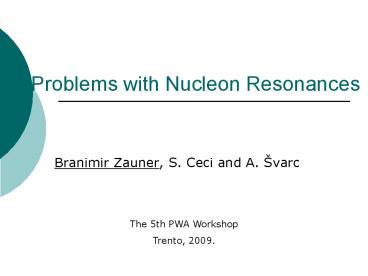Problems with Nucleon Resonances PowerPoint PPT Presentation
1 / 23
Title: Problems with Nucleon Resonances
1
Problems with Nucleon Resonances
- Branimir Zauner, S. Ceci and A. Švarc
The 5th PWA Workshop Trento, 2009.
2
Outline
- Problem with RPP by PDG
- Problems with PWAs
- Problems with parameters and their extraction
- The Third Set of Parameters
- Roper
3
Problem with RPP by PDG
- They are providing polar and BW parameters for
baryons, and only polar parameters for mesons. - I have no idea what they are averaging!
4
Problems with PWAs
- It is a massive, difficult, time consuming and
nerve-wrecking job with little or none rewards. - The difficulty lies here
- Proper analyticity
- Unitarity
- Multichannel
- ? There are very few new analyses.
5
Problems with parameters
- For baryons we have 2 sets of parameters.
- Is it too much or too little?
- Which set is more physical? Is any?
- What information do we get from those sets?
- Are they connected somehow?
- There is consensus that resonances are
characterized by T-matrix pole parameters - There is consensus that excited nucleon states
are characterized by Breit-Wigner parameters.
6
Problems with extraction I
- Almost everyone who extracts Breit-Wigner
parameters uses house-rules to do it. - How can one make an amplitude from those
parameters?
7
Problems with extraction II
- Going from the real axis to the complex energy
plane is intrinsically model dependent. ? house
rules - Speed plot is basically wrong.
- Regularization method is not so easy to apply.
Ceci et al. PHYSICAL REVIEW D 77, 116007 (2008)
8
The Third Set of Parameters
- These are the so-called bare parameters.
- ? bare mass
- Dressing a bare mass produces a dressed
T-matrix pole.
9
Our Model
We are dressing bare masses from G0 with
effective interaction. We are not calculating
each and every one Feynmann diagram, our coupling
constants and bare masses are fit parameters.
10
The Third Set of Parameters
- We have recently compared bare mass to the
results of CQM.
Ceci et al. Eur. Phys. J. C (2008) 58 4756
11
Roper
12
Roper
- ... Unexpectedly, however, the P11 state
exhibited resonance-like behavior near 600 MeV
even though no resonance parameterization was
used for it. I tried many times to freeze the P11
state into some non-resonant behavior while
varying all other partial waves. But every time,
upon release, the P11 would change to look like a
resonance. And a slightly better fit would be
achieved by assuming a resonance form for the P11
state...
13
Roper EPJC
Dataset was AR05 pN??N from ZG98
14
How did we get graphs like that?
15
How did we get graphs like that?
16
How do we get graphs like that?
17
How do we get graphs like that?
18
How do we get graphs like that?
19
Roper
20
Roper
The dressed pole did not dissapear until all
three background poles were switched off!
21
What are the consequences?
- Maybe the result is dataset-dependent?
- KH80, ZG98, AR05 and AR05ZG98 exhibit the same
behaviour. - Maybe it is an artefact of the CMB model?
- Why only Roper?
- Maybe there is a deeper meaning to this?
22
Deeper meaning speculation
- We have two different types of resonances, and
CMB model can identify which one belongs where. - ? We have to look for more Roper-like resonances.
- We are open to new ideas and suggestions.
23
The End?

